Research on Rockburst Risk Level Prediction Method Based on LightGBM−TCN−RF
Abstract
:1. Introduction
2. Rockburst Monitoring Data Processing
2.1. Rockburst Monitoring Data Acquisition
2.2. Rockburst Data Processing
2.2.1. Rockburst Data Preprocessing
2.2.2. Rockburst Characteristic Variables Screening
3. Rockburst Characteristic Variable Prediction Model
3.1. Building Process of Rockburst Characteristic Variable Prediction Model
3.2. Rockburst Characteristic Variable Prediction Modeling
3.3. Comparative Analysis of the Performance of Rockburst Characteristic Variable Prediction Models
4. Rockburst Risk Level Classification Model
4.1. Rockburst Risk Level Classification Model Building Process
4.2. Rockburst Risk Level Classification Modeling
4.3. Rockburst Risk Level Classification Model Comparison
4.4. Rockburst Risk Level Classification Model Optimization
5. Conclusions
Author Contributions
Funding
Conflicts of Interest
References
- Xie, H.P. Research progress on deep rock mechanics and mining theory. J. China Coal Soc. 2019, 44, 1283–1305. [Google Scholar]
- Jiang, Y.D.; Pan, Y.S.; Jiang, F.X.; Dou, L.M.; Ju, Y. Mechanism and prevention of rock explosion in coal mining in China. J. China Coal Soc. 2014, 39, 205–213. [Google Scholar]
- Xia, Y.X.; Pan, J.F.; Xie, F.; Sun, X.D.; Lu, C.; Zhang, C.Y.; Liu, S.H. Research on the mechanism and application of long−hole fracture pressure relief and anti-scouring in rock-bursting back-hole mining. J. China Coal Soc. 2022, 1–11. [Google Scholar] [CrossRef]
- Dou, L.M.; Tian, X.Y.; Cao, A.Y.; Gong, S.Y.; He, H.; He, J.; Cai, W.; Li, X.W. Current situation and problems of rock explosion prevention and control in China’s coal mines. J. China Coal Soc. 2022, 47, 152–171. [Google Scholar]
- Zhang, J.W.; Zhong, S. Research progress and technical system analysis of rock explosion disaster in China’s coal mines. Coal Technol. 2021, 40, 105–108. [Google Scholar]
- Dou, L.M.; Zhou, K.Y.; Song, S.K.; Cao, A.Y.; Cui, H.; Gong, S.Y.; Ma, X.T. Research on the mechanism, monitoring and warning, and prevention and control technology of coal mine impact pressure. J. Eng. Geol. 2021, 29, 917–932. [Google Scholar]
- Yan, Y.D.; Pan, J.F.; Xi, G.J.; Jiao, B.; Shi, X. Analysis and prevention of impact hazards in the squared-off tectonic zone of consolidated mining. Ind. Mine Autom. 2021, 47, 7–13. [Google Scholar]
- Zhang, W.J. Prediction and Prevention Technology of Rockburst in Deep Buried Extra-Thick Coal Seam Roadway in Mengcun Mine. Master’s Thesis, Xi’an University of Science and Technology, Xi’an, China, 2019. [Google Scholar]
- Zuo, L.Y. Rockburst hazard prediction of the isolated working face based on multi-factor analysis. Coal Eng. 2019, 51, 96–100. [Google Scholar]
- Wu, J.F.; Cheng, Y.F.; Liang, Y.H.; Zhang, F.; Guo, X.F. Rockburst hazard level prediction by fuzzy C-mean clustering algorithm. J. Heilongjiang Univ. Sci. Technol. 2021, 31, 350–353+365. [Google Scholar]
- Zhu, F.; Zhang, H.W. CW-TOPSIS rockburst evaluation model based on the “AHP + entropy weight method”. China Saf. Sci. J. 2017, 27, 128–133. [Google Scholar]
- Wen, T.X.; Li, Y.Z. Preprocessing-based AFOA-ELM rockburst hazard prediction model. China Saf. Sci. J. 2019, 29, 29–34. [Google Scholar]
- Lv, P.F.; Qiu, L. Research on rockburst classification prediction in mines based on PSO-LSSVM. Min. Saf. Environ. Prot. 2021, 48, 120–125. [Google Scholar]
- Zhang, J.; Wang, M.X.; Xi, C.H.; Feng, G. Prediction and Evaluation of Rockburst Based on Depth Neural Network. Adv. Civ. Eng. 2021, 2021, 8248443. [Google Scholar] [CrossRef]
- Chen, J.; Gao, J.K.; Pu, Y.Y.; Jiang, D.Y.; Qi, Q.X.; Wen, Z.J.; Sun, Q.L.; Chen, L.L. A machine learning approach for rockburst prediction and early warning. J. Min. Strat. Control Eng. 2021, 3, 57–68. [Google Scholar]
- Zhang, K. Research on Multiparameter Integrated Early Warning of Coal Column Type Rockburst Based on Neural Network Analysis. Master’s Thesis, Shandong University of Science and Technology, Qingdao, China, 2018. [Google Scholar]
- Liu, H.M.; Xu, F.Y.; Liu, B.J.; Deng, M. A CNN-LSTM-based method for temporal prediction of rockburst hazard level. J. Cent. South Univ. (Sci. Technol.) 2021, 52, 659–670. [Google Scholar]
- Zhang, X.F.; Qu, X.C.; Wei, Q.D. Development and application of a multidimensional multiparameter monitoring and warning platform for rock blast. J. Min. Strat. Control Eng. 2021, 3, 69–78. [Google Scholar]
- Ding, J.J.; Sun, Y. LightGBM-based multi-category prediction of flight delays. J. Nanjing Univ. Aeronaut. Astronaut. 2021, 53, 847–854. [Google Scholar]
- Li, Z.S.; Yao, X.; Liu, Z.G.; Zhang, J.C. Feature selection algorithm based on LightGBM. J. Northeast. Univ. (Nat. Sci.) 2021, 42, 1688–1695. [Google Scholar]
- Liu, F. Research on a Comprehensive Prediction Method of Coal Mine Impact Hazard Based on Machine Learning. Doctoral Dissertation, Shandong University of Science and Technology, Qingdao, China, 2020. [Google Scholar]
- Zhao, H.R.; Zhao, Y.H.; Guo, S. Short-term electric load forecasting is based on the empirical modal decomposition of complementary sets and long- and short-term memory neural networks. Electr. Power 2020, 53, 48–55. [Google Scholar]
- Peng, Y.; Meng, Z.Q.; Yang, L.N. A speech enhancement method based on GRU neural network. J. Guangxi Univ. 2021, 46, 1533–1548. [Google Scholar]
- Fu, Y.; Ren, Z.X.; Wei, S.R.; Wang, Y.; Huang, L.L.; Jia, F. Ultra short term power prediction of offshore wind power based on improved lstm-tcn model. Proc. CSEE 2022, 42, 4292–4303. [Google Scholar] [CrossRef]
- Nie, Q.Q.; Wan, D.S.; Zhu, Y.L.; Li, Z.J.; Yao, C. Hydrological model based on time-domain convolutional neural network. J. Comput. Appl. 2022, 042, 1756–1761. [Google Scholar]
- Bian, Z.K.; Zhang, J.; Wang, S.T. KNN classification algorithm based on class label perception. J. Pattern Recognit. Artif. Intell. 2021, 34, 873–884. [Google Scholar] [CrossRef]
- Zhang, Y.; Ren, H.X.; Wang, D.L. The intelligent evaluation system of ship maneuvering is based on the KNN algorithm. J. Shanghai Marit. Univ. 2021, 42, 33–38. [Google Scholar]
- Yang, W.B.; Wang, Z.X.; Tian, H.S.; Wu, F.Y.; Yang, Z.C. Large deformation prediction method for laminated soft rock tunnel based on PSO-SVM algorithm. Hazard Control Tunn. Undergr. Eng. 2022, 1–10. [Google Scholar] [CrossRef]
- Zhang, M.; Chen, J.H.; Zhou, Z.H. SVM-based rockburst classification prediction model and R language implementation. Chin. J. Geol. Hazard Control 2018, 29, 64–69. [Google Scholar]
- Wan, Q.Z.; Wu, K.C. Islanding detection of DC microgrid based on random forest classification. J. Acta Energ. Sol. Sin. 2022, 43, 269–276. [Google Scholar] [CrossRef]
- Wang, Z.Y.; Zhang, M.Y.; Yu, Y.R.; Ni, P. A random forest sea ice fine classification method integrated texture features and NDVI. Acta Oceanol. Sin. 2021, 43, 149–156. [Google Scholar]
- Gu, Y.F.; Zhang, D.Y.; Ruan, J.F.; Wang, Q.; Bao, Z.D.; Zhang, H.Z. A new model for permeability prediction in oil and gas reserve evaluation. Prog. Geophys. 2022, 37, 588–599. [Google Scholar]
- Zhang, M.C. Prediction of rockburst hazard based on particle swarm algorithm and neural network. Neural Comput. Appl. 2022, 34, 2649–2659. [Google Scholar] [CrossRef]
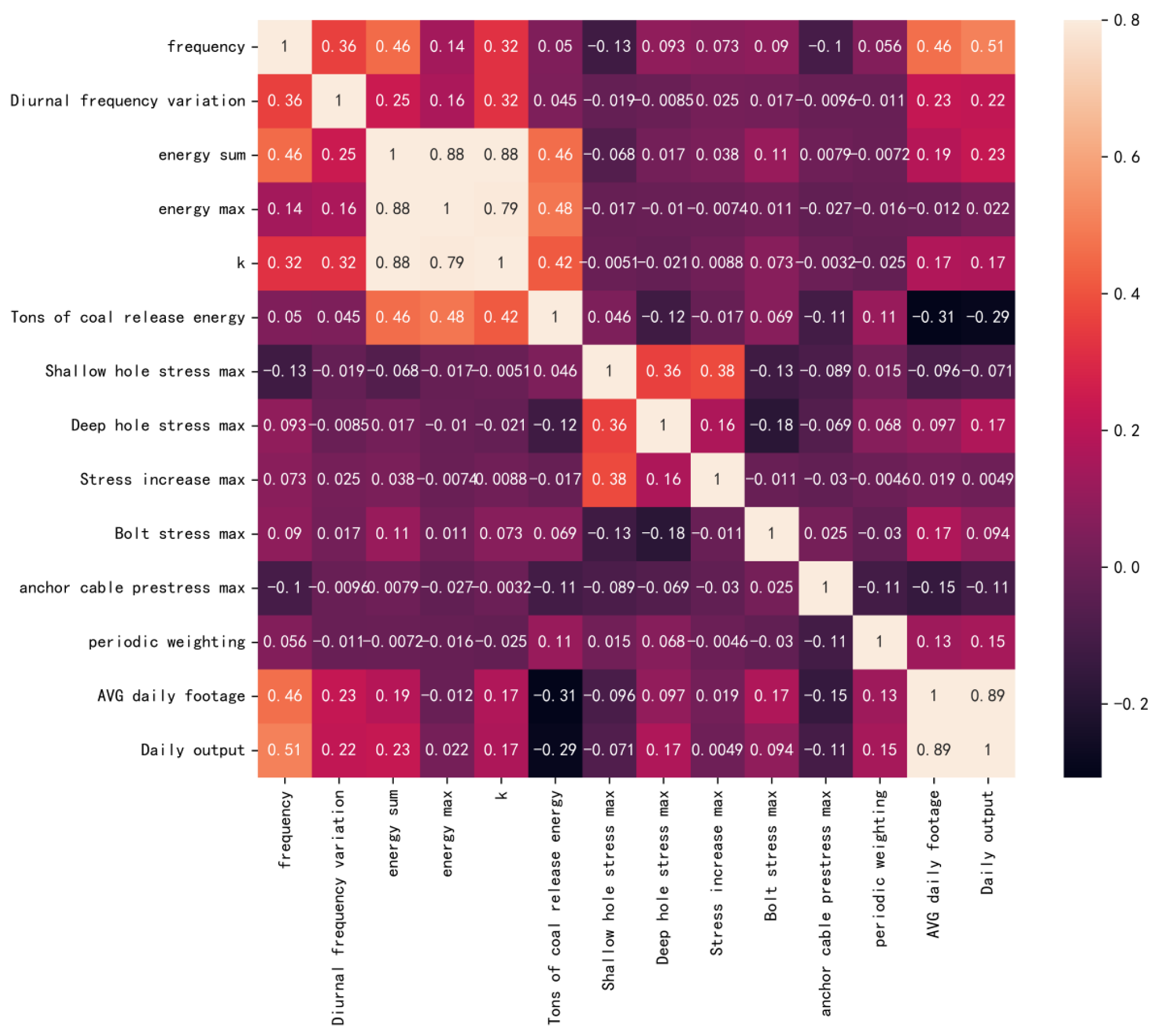
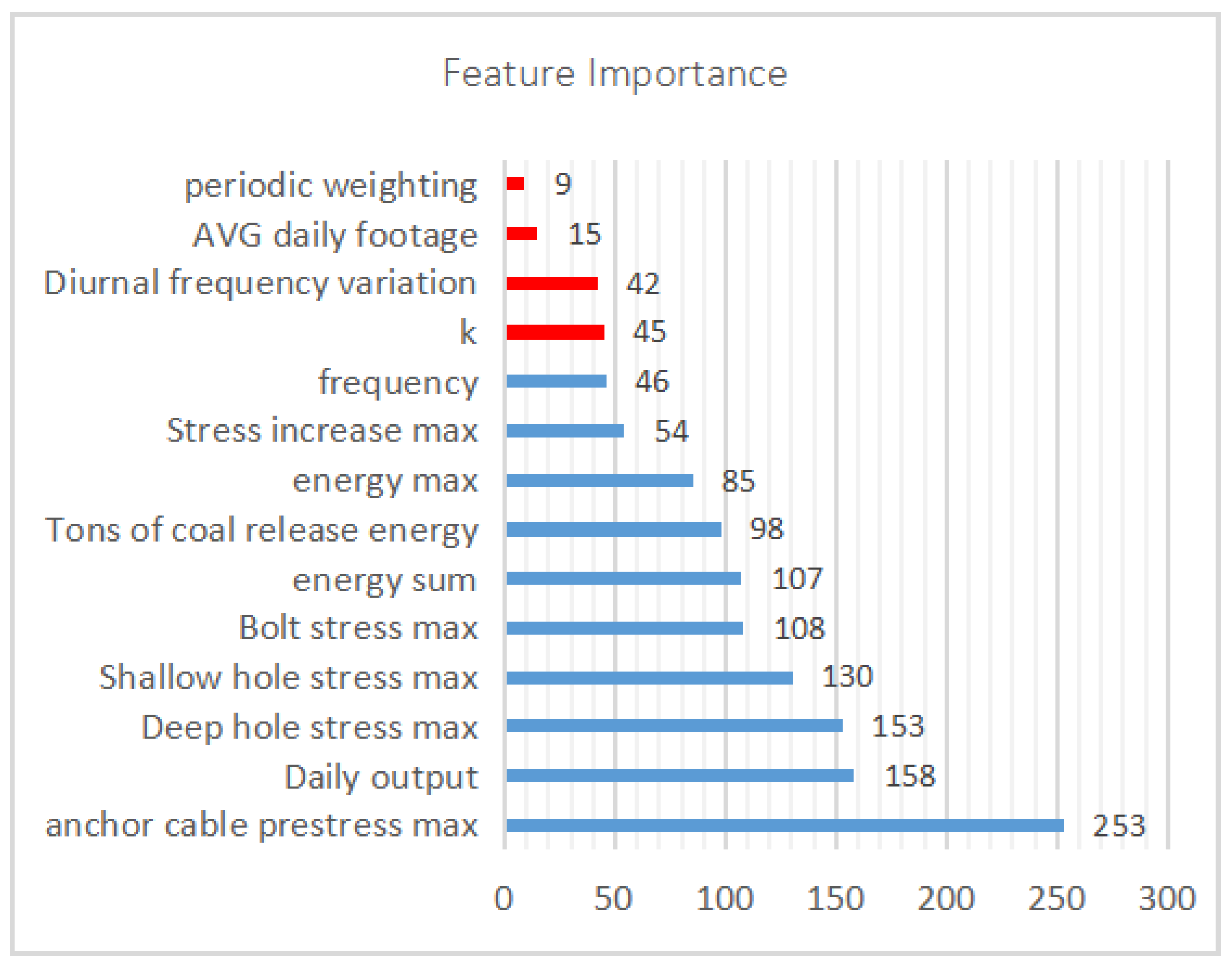
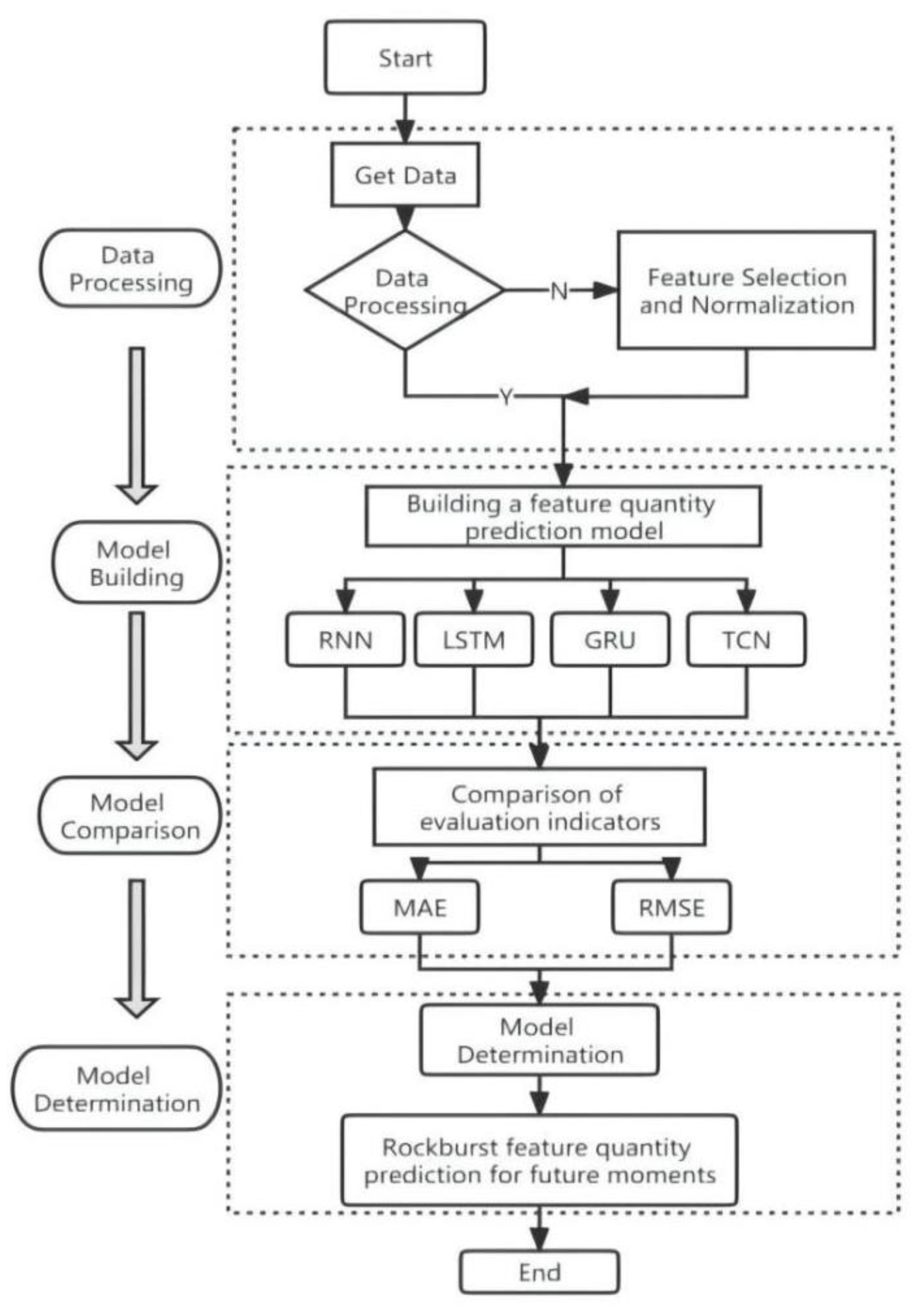
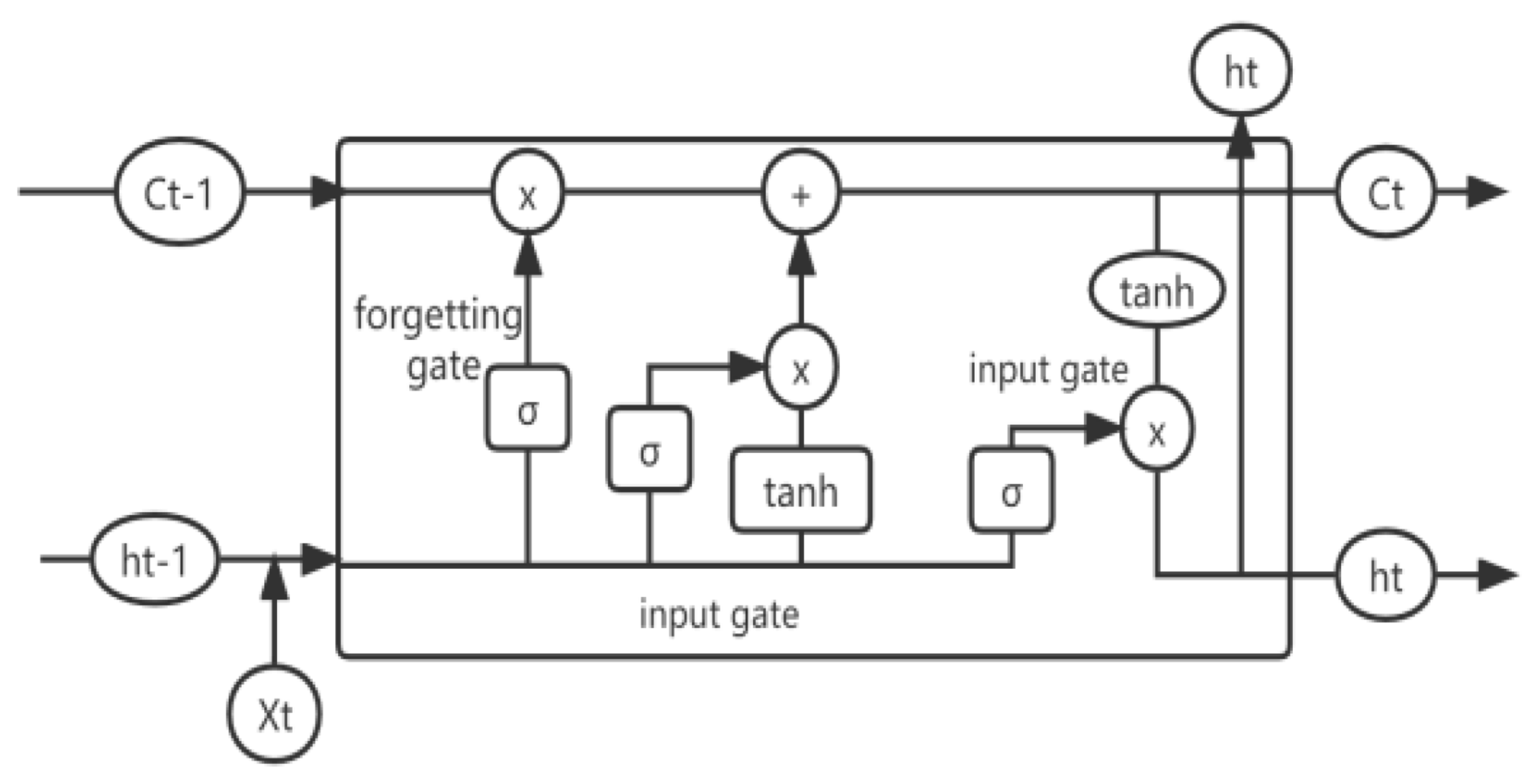
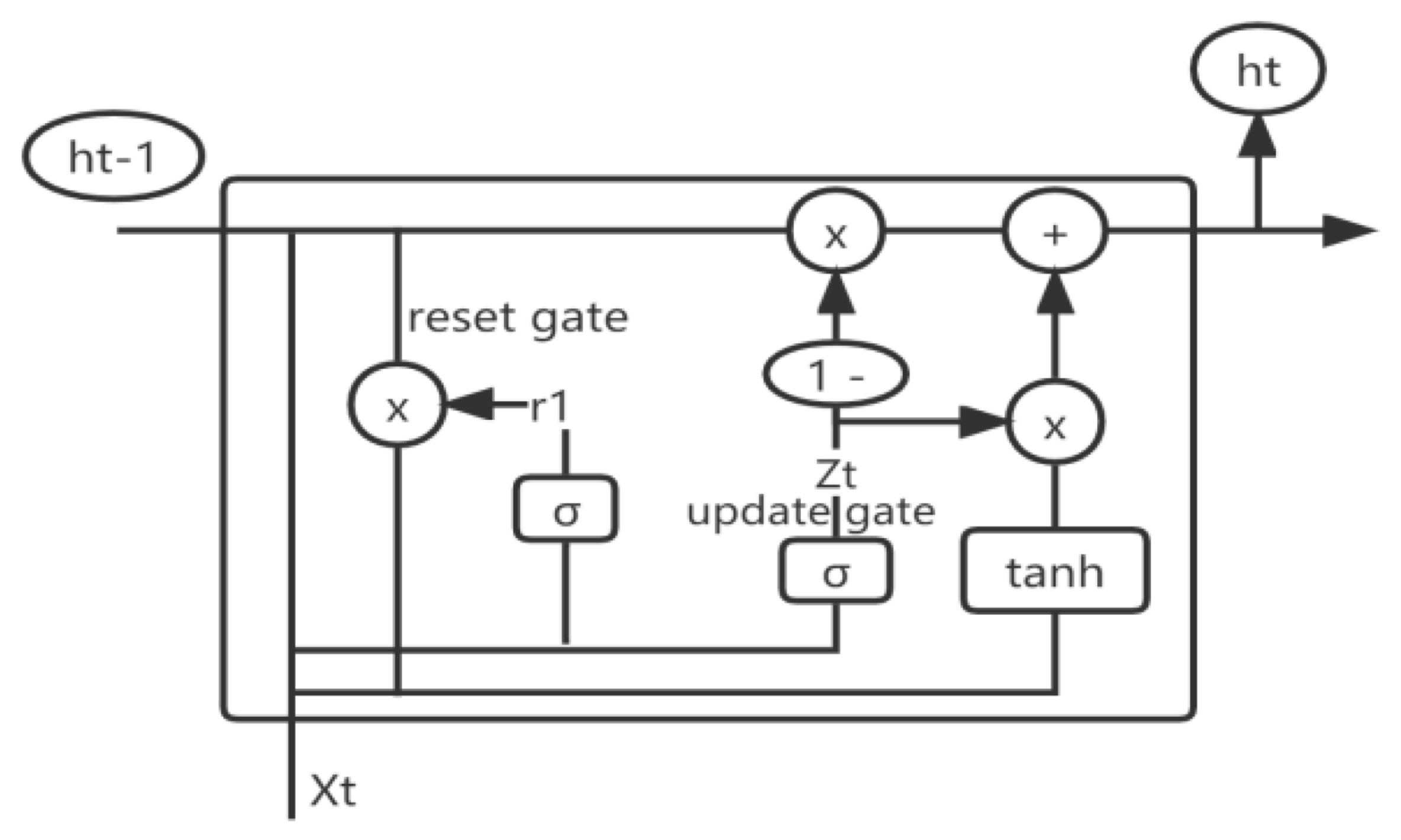



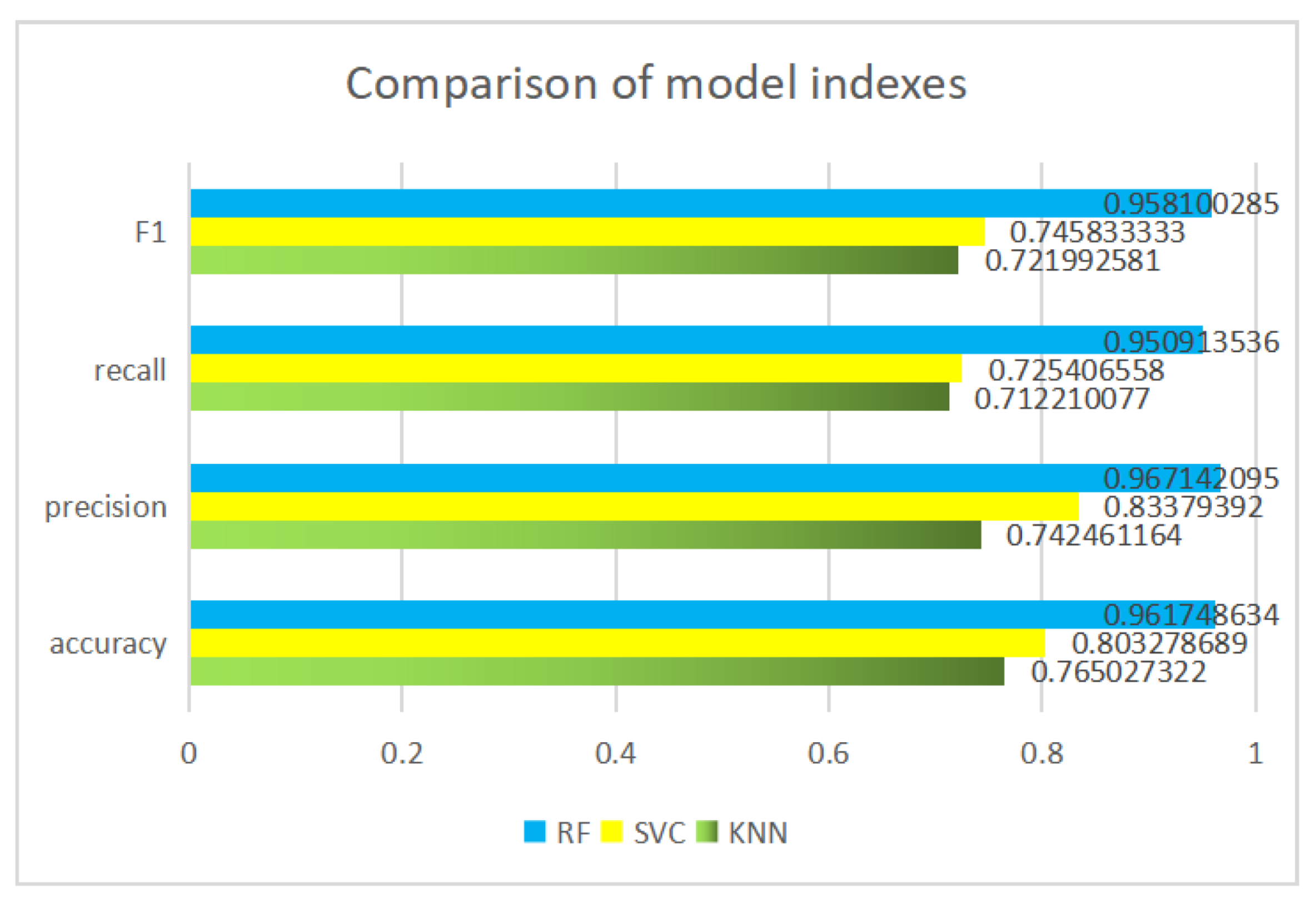
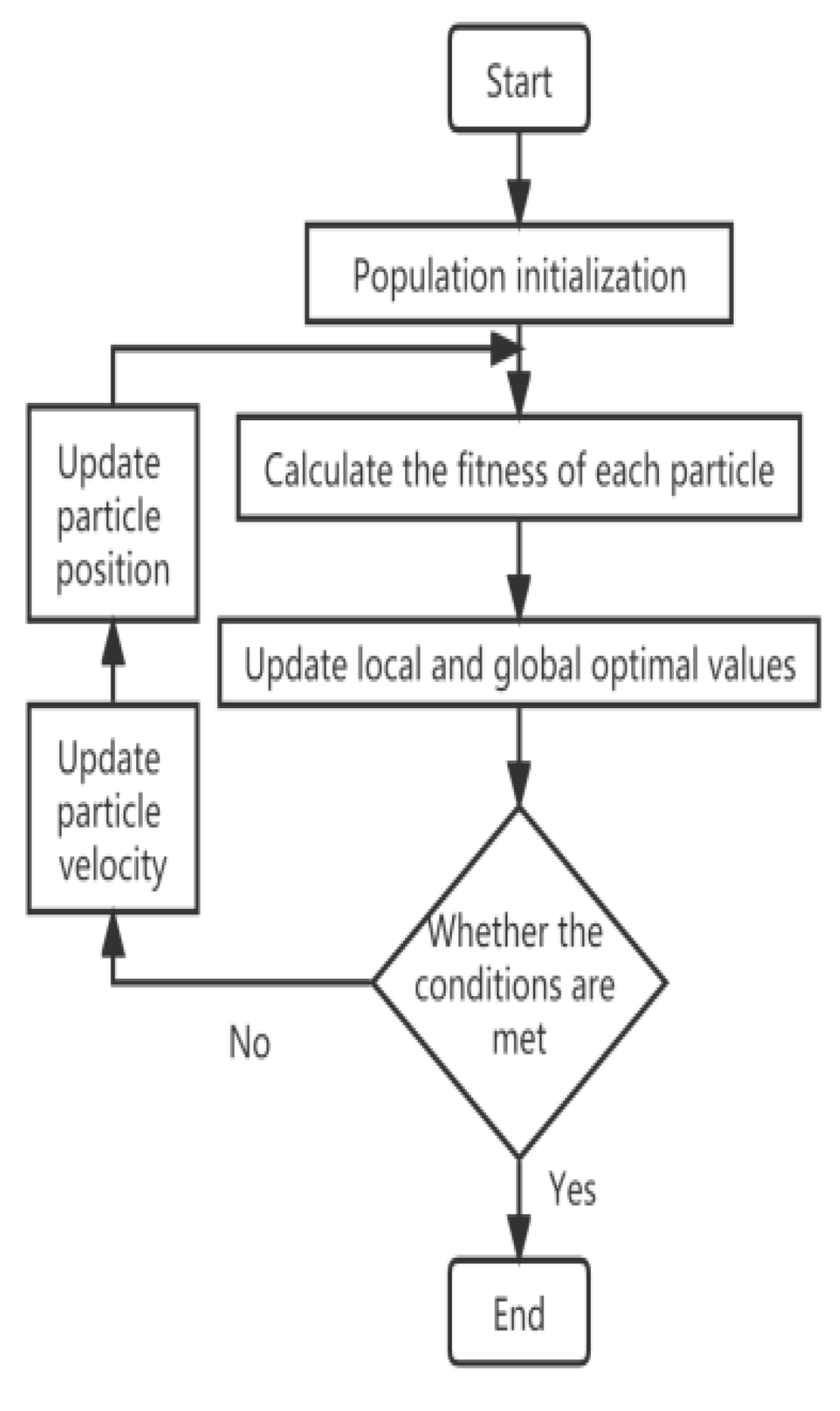
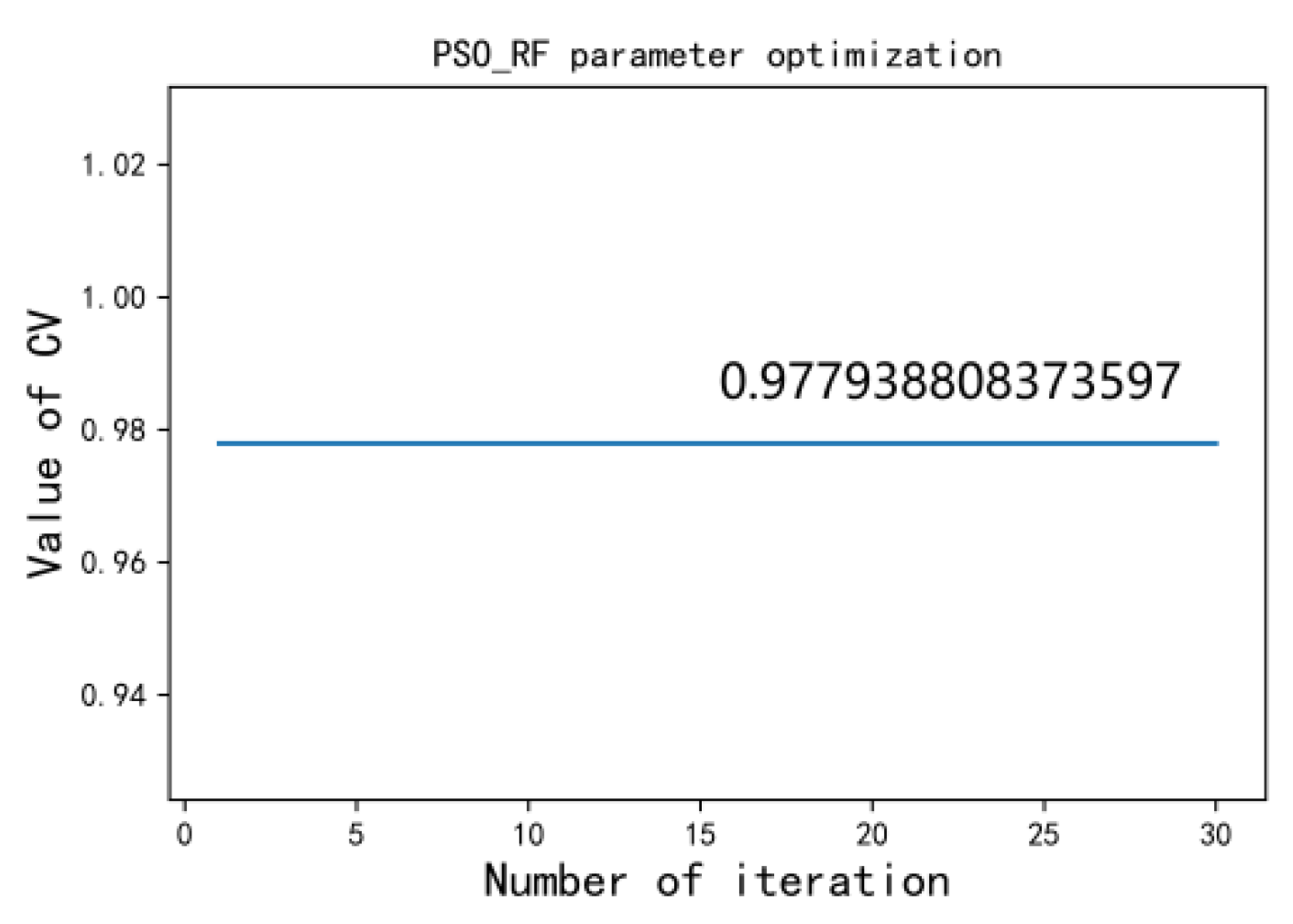
| X1 | X2 | X3 | X4 | X5 | X6 | X7 | X8 | X9 | X10 | X11 | X12 | X13 | X14 | Risk Level | |
|---|---|---|---|---|---|---|---|---|---|---|---|---|---|---|---|
| 1 | 33 | 0 | 16,800 | 2990 | 1.039477928 | 1.531868332 | 7.6 | 6.7 | 0 | 68 | 138 | 0 | 2.4 | 10,967 | 0 |
| 2 | 46 | 13 | 21,600 | 2990 | 1.039477928 | 1.207041073 | 8 | 10 | 4.3 | 68 | 138 | 0 | 3.2 | 17,895 | 0 |
| 3 | 55 | 9 | 22,600 | 4360 | 1.039477928 | 1.329646408 | 8.2 | 10.4 | 0.5 | 68 | 138 | 0 | 4 | 16,997 | 0 |
| … | … | … | … | … | … | … | … | … | … | … | … | … | … | … | … |
| 453 | 52 | −6 | 21,400 | 2890 | 1.477798495 | 2.127025147 | 7.6 | 7.7 | 0.5 | 80 | 103 | 0 | 2.4 | 10,061 | 1 |
| 454 | 40 | −12 | 13,700 | 3010 | 0.89478153 | 7.413419913 | 7.6 | 7.7 | 0.1 | 80 | 103 | 0 | 0 | 1848 | 1 |
| 455 | 29 | −11 | 4790 | 829 | 0.310615395 | 6.490514905 | 7.4 | 7.5 | 0.1 | 80 | 103 | 0 | 0 | 738 | 1 |
| 456 | 19 | −10 | 9900 | 2600 | 0.675306958 | 2.265446224 | 7.4 | 7.5 | 0.4 | 80 | 103 | 0 | 1.6 | 4370 | 1 |
| X1 | X2 | X3 | X4 | X5 | X6 | X7 | X8 | X9 | X10 | X11 | X12 | X13 | X14 | |
|---|---|---|---|---|---|---|---|---|---|---|---|---|---|---|
| X1 | 1.000 | 0.363 | 0.455 | 0.138 | 0.320 | 0.050 | −0.126 | 0.093 | 0.073 | 0.090 | −0.101 | 0.463 | 0.508 | 0.056 |
| X2 | 0.363 | 1.000 | 0.246 | 0.162 | 0.323 | 0.045 | −0.019 | −0.008 | 0.025 | 0.017 | −0.010 | 0.225 | 0.218 | −0.011 |
| X3 | 0.455 | 0.246 | 1.000 | 0.885 | 0.880 | 0.462 | −0.068 | 0.017 | 0.038 | 0.114 | 0.008 | 0.186 | 0.230 | −0.007 |
| X4 | 0.138 | 0.162 | 0.885 | 1.000 | 0.793 | 0.482 | −0.017 | −0.010 | −0.007 | 0.011 | −0.027 | −0.012 | 0.022 | −0.016 |
| X5 | 0.320 | 0.323 | 0.880 | 0.793 | 1.000 | 0.417 | −0.005 | −0.021 | 0.009 | 0.073 | −0.003 | 0.174 | 0.166 | −0.025 |
| X6 | 0.050 | 0.045 | 0.462 | 0.482 | 0.417 | 1.000 | 0.046 | −0.122 | −0.017 | 0.069 | −0.112 | −0.308 | −0.290 | 0.113 |
| X7 | −0.126 | −0.019 | −0.068 | −0.017 | −0.005 | 0.046 | 1.000 | 0.361 | 0.381 | −0.126 | −0.089 | −0.096 | −0.071 | 0.015 |
| X8 | 0.093 | −0.008 | 0.017 | −0.010 | −0.021 | −0.122 | 0.361 | 1.000 | 0.164 | −0.183 | −0.069 | 0.097 | 0.172 | 0.068 |
| X9 | 0.073 | 0.025 | 0.038 | −0.007 | 0.009 | −0.017 | 0.381 | 0.164 | 1.000 | −0.011 | −0.030 | 0.019 | 0.005 | −0.005 |
| X10 | 0.090 | 0.017 | 0.114 | 0.011 | 0.073 | 0.069 | −0.126 | −0.183 | −0.011 | 1.000 | 0.025 | 0.170 | 0.094 | −0.030 |
| X11 | −0.101 | −0.010 | 0.008 | −0.027 | −0.003 | −0.112 | −0.089 | −0.069 | −0.030 | 0.025 | 1.000 | −0.152 | −0.107 | −0.109 |
| X12 | 0.463 | 0.225 | 0.186 | −0.012 | 0.174 | −0.308 | −0.096 | 0.097 | 0.019 | 0.170 | −0.152 | 1.000 | 0.888 | 0.129 |
| X13 | 0.508 | 0.218 | 0.230 | 0.022 | 0.166 | −0.290 | −0.071 | 0.172 | 0.005 | 0.094 | −0.107 | 0.888 | 1.000 | 0.149 |
| X14 | 0.056 | −0.011 | −0.007 | −0.016 | −0.025 | 0.113 | 0.015 | 0.068 | −0.005 | −0.030 | −0.109 | 0.129 | 0.149 | 1.000 |
| Model\Indicators | RMSE Mean Value | MAE Mean Value |
|---|---|---|
| RNN | 0.129 | 0.0823 |
| LSTM | 0.180 | 0.131 |
| GRU | 0.173 | 0.104 |
| TCN | 0.124 | 0.079 |
| Rockburst Characteristic Variables | X1 | X3 | X4 | X6 | X7 | X8 | X9 | X10 | X11 | X13 | Rockburst Risk Level |
|---|---|---|---|---|---|---|---|---|---|---|---|
| Forecast at the moment t + 1 | 63 | 22,796 | 4534 | 2.295048 | 7.8 | 7.6 | 0.1 | 79 | 125 | 10,715 | To be tested |
| Rockburst Characteristic Variables | X1 | X3 | X4 | X6 | X7 | X8 | X9 | X10 | X11 | X13 | Rockburst Risk Level |
|---|---|---|---|---|---|---|---|---|---|---|---|
| Forecast at the moment t + 1 | 63 | 22,796 | 4534 | 2.295048 | 7.8 | 7.6 | 0.1 | 79 | 125 | 10,715 | No risk |
Publisher’s Note: MDPI stays neutral with regard to jurisdictional claims in published maps and institutional affiliations. |
© 2022 by the authors. Licensee MDPI, Basel, Switzerland. This article is an open access article distributed under the terms and conditions of the Creative Commons Attribution (CC BY) license (https://creativecommons.org/licenses/by/4.0/).
Share and Cite
Ma, L.; Cai, J.; Dai, X.; Jia, R. Research on Rockburst Risk Level Prediction Method Based on LightGBM−TCN−RF. Appl. Sci. 2022, 12, 8226. https://doi.org/10.3390/app12168226
Ma L, Cai J, Dai X, Jia R. Research on Rockburst Risk Level Prediction Method Based on LightGBM−TCN−RF. Applied Sciences. 2022; 12(16):8226. https://doi.org/10.3390/app12168226
Chicago/Turabian StyleMa, Li, Jiajun Cai, Xinguan Dai, and Ronghao Jia. 2022. "Research on Rockburst Risk Level Prediction Method Based on LightGBM−TCN−RF" Applied Sciences 12, no. 16: 8226. https://doi.org/10.3390/app12168226
APA StyleMa, L., Cai, J., Dai, X., & Jia, R. (2022). Research on Rockburst Risk Level Prediction Method Based on LightGBM−TCN−RF. Applied Sciences, 12(16), 8226. https://doi.org/10.3390/app12168226






